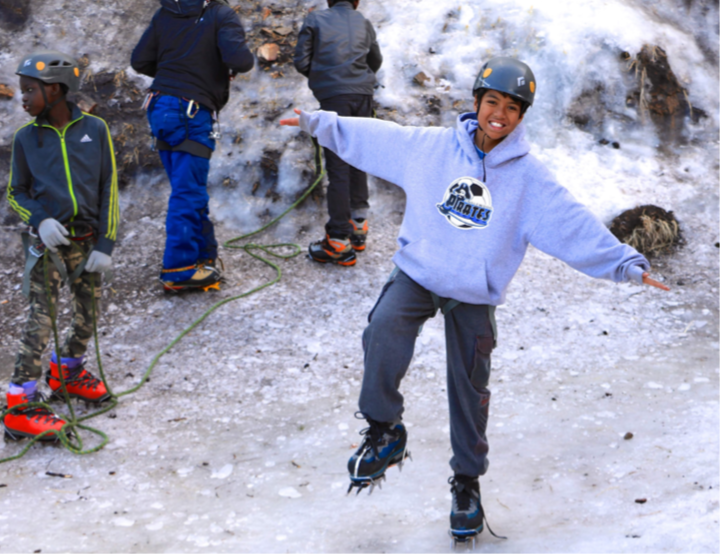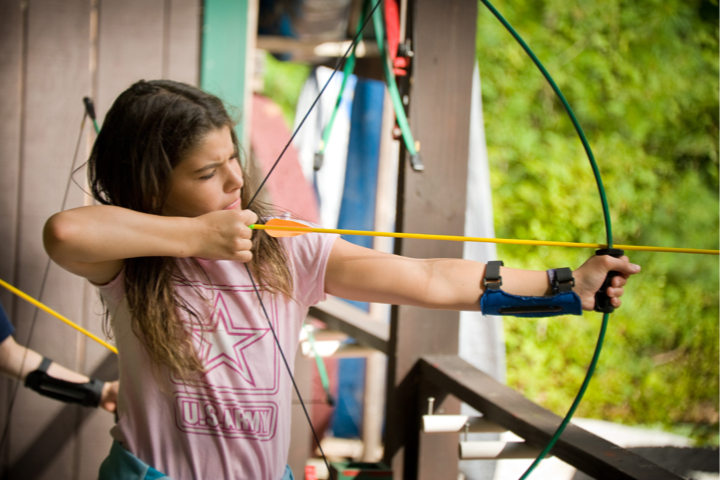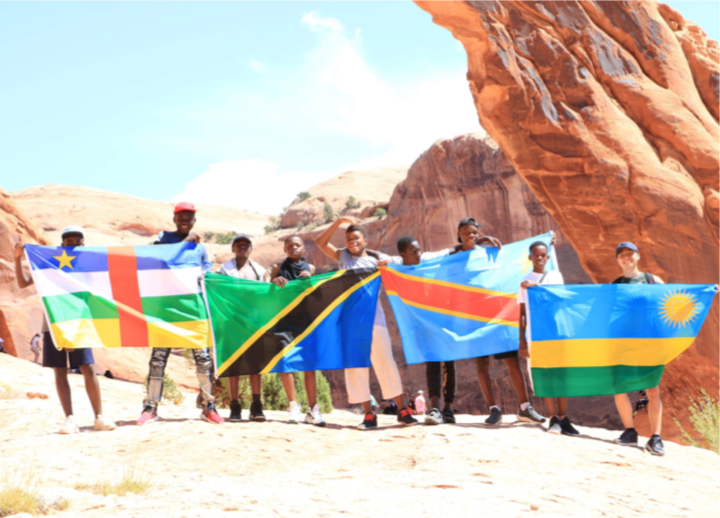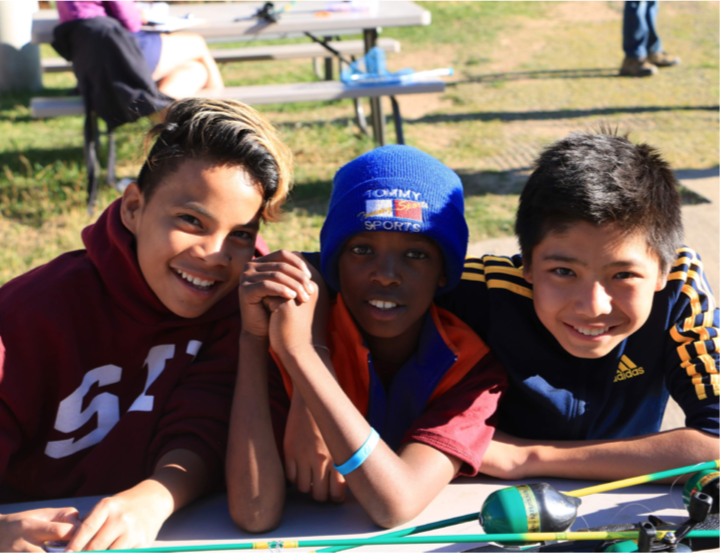Inclusive Scouting Guide
Return to Introduction
Part 1: Defining Important Concepts
“Be open to those who are not just like everyone else you know. Differences in race, culture, and language may keep some people at a distance, but those differences can also be doorways for you to expand your understanding of other people and of the world.” — Boy Scout Handbook, 13th Edition, p.44-45
Scouting in America should be as vibrant and diverse as America itself. Scouting is a movement where people can learn from one another and share life together across differences of race, color, ethnicity, sex, gender expression, nationality, language, sexuality, ability, religious beliefs, or family income. It’s a movement with the potential to celebrate commonality as well as difference. This is important, because if we forget to honor both commonality and difference, we risk repeating the mistakes of the past. When we forget to respect the vast complexity of human diversity, we fail to live the Scout Oath and Law to the greatest extent possible. By honoring this complexity, we leverage the power of the Oath and Law as tools for navigating difference while celebrating our common humanity.
This section outlines important concepts that help us leverage the power of the Scout Oath and Law. First, we define each term by using the Oxford English Dictionary. Then, we clarify these definitions through other resources related to Scouting in the US and around the world. Additional sources come from cutting edge research in psychology, business, and social science.
These are broad “snapshots” of each concept. While these snapshots are not meant to be comprehensive, they can help Scouts and Scouters communicate and collaborate effectively to advance inclusion and belonging in our movement.
After outlining the importance of inclusion and belonging, we’ll explore other valuable concepts for living these values in Scouting. These important concepts are: diversity, equality, exclusion, discrimination, bias, stereotype, and identity.
We begin with our two key terms: inclusion and belonging. Everyone wants to feel included and to know they belong. Achieving true inclusion and belonging for all, however, requires strong intentions, significant resources, and a passion for lifelong learning.
Inclusion: “The action or state of including or of being included within a group or structure.” (4)
Inclusion in Scouting means actively building a movement where diverse communities can benefit from and contribute to Scouting regardless of race, ethnicity, culture, gender expression, sexuality, ability, national origin, spirituality, or family income. Inclusion in Scouting means celebrating and learning from difference, even when it may be challenging.
According to the World Organization of the Scout Movement (WOSM):
“Our challenge is to develop and improve our programme and delivery approaches so that they are inclusive by design and not just by adaptation. We want to make Scouting more meaningful and relevant by embracing everyone.” (5)
Sometimes it’s easy to assume Scouting is inclusive, especially if we personally feel, or have always felt, included. However, we can’t assume that century-old habits of discrimination and exclusion can be transformed overnight. As WOSM states:
“It is important that all members can recognise barriers that may delay inclusion and be active in addressing these. Inclusion uses the potential of diversity to achieve greater creativity and innovation within our membership and the movement.” (6)
In order to transform old habits, we need to take action and intentionally practice new habits of inclusion for all.
Belonging: “An affinity for a place or situation.” (7)
Belonging in Scouting means that those who have been discriminated and excluded in the past know that we truly value their presence, affirm their inherent worth and dignity through our actions, and value their contributions to our movement. Belonging must extend to those who have been told they are not welcome in Scouting, as well as those who have always felt welcome.
According to John A. Powell and Stephen Menendian, directors of the Haas Institute for a Fair and Inclusive Society, belonging “entails an unwavering commitment to not simply tolerating and respecting difference but to ensuring that all people are welcome and feel that they belong in the society.” (8)
We emphasize the importance of inclusion and belonging because we need both to ensure we are living Scouting’s fundamental values. Mere inclusion of people who have been discriminated against by our movement may not actually make them feel like they belong in Scouting—even if we now give them permission to wear our uniform. Being included “in the room” is not the same as feeling like you belong “in the room”.
Belonging without inclusion is also insufficient. Many people know and feel they belong in Scouting. Especially those who have never been excluded or discriminated against on the basis of their race, gender expression, sexuality, ability, or spiritual beliefs. Since these people have always had access to the resources of Scouting, it’s no surprise that they feel like they belong, since Scouting never tried to keep them out in the first place. True belonging can only happen when we welcome, embrace, learn from, and include people who have been intentionally and unintentionally excluded.
When historically excluded communities, as well as those who have never been excluded, feel like they belong in Scouting, then inclusion and belonging are working harmoniously for the benefit of everyone.
Advancing this goal means that old habits and narrow assumptions about what Scouting is and who it’s for will have to change. If we can achieve both true inclusion and full belonging in our movement, we will be living the Scout Oath and Law to the fullest extent possible.
Other Important Concepts for Advancing Inclusion and Belonging in Scouting
“Understanding more about the challenges others face is a step toward getting to know people for who they really are.” — Boy Scout Handbook, 13th Edition, p.64

Diversity: “Showing a great deal of variety; very different.” (9)
Diversity in Scouting means that the BSA should reflect the rich varieties of experience and knowledge found throughout America.
Our peers from The Scout Association in the United Kingdom write:
“The term ‘diversity’ can be interpreted in many ways. It is often taken to mean the differences in the values, attitudes, cultural perspective, beliefs, ethnic background, sexual orientation, ability or disability, skills, knowledge, age and life experiences of each individual in any group of people. Valuing diversity refers to developing an accessible and inclusive environment where everyone feels welcome and valued and can contribute to their fullest potential.” (10)
Diversity means more than having one “token” member of a community serving as a stand-in for true and organic diversity. If diverse communities are not engaging with your program, the first question should not be “how do we include more diverse communities in Scouting?” Rather, the first question should be, “Is there something about our program that is causing diverse communities to feel like they don’t belong?” Or, more fundamentally, we should be asking, “Do our youth and volunteers know how to interact with people from different backgrounds?”
As WOSM clarifies:
“It is essential that [National Scout Organizations] demonstrate actively that diversity is something that is valued and practised within Scouting, by being an open and inclusive movement and promoting access to Scouting for all people.” (11)
“The United States of America is an ongoing experiment in how people can work together for the good of all.” — Boy Scout Handbook, 13th Edition, p.54
Equality: “The state of being equal, especially in status, rights, or opportunities.” (12)
The values of inclusion and belonging are rooted in a commitment to one of our most fundamental American values: All people are created equal. Achieving equal opportunities and accommodations for all is a way of advancing inclusion and belonging. It should also be a natural outcome of truly living Scouting’s most fundamental values.
As The Scout Association clarifies:
“Equal opportunities refers to the development of practices that promote the possibility of fair and equal chances for all to develop their full potential, in all aspects of life, and the removal of barriers to discrimination and disadvantage experienced by certain groups.” (13)
In order to transform barriers to equality, it is important to understand root causes of inequality which aren’t always easy to see.
Exclusion: “[To] deny (someone) access to a place, group, or privilege.” (14)
“Americans are as different from one another as the land upon which we live. Even so, when we work together we have the energy, optimism, and ability to accomplish almost anything we set out to do.” — Boy Scout Handbook, 13th Edition, p.70
The intentional or unintentional exclusion of individuals and entire communities is a major barrier to equality, inclusion and belonging.
In the United Kingdom, where Scouting was born, our fellow Scouts and Scouters state that exclusion
“…describes what can happen when people or areas suffer from a combination of linked problems such as unemployment, poor skills, low incomes, poor housing, high crime environments, bad health and family breakdown. Those who experience social exclusion are, for whatever reason, prevented from participating in or benefiting from a range of opportunities available to members of society.” (15)
Many people have been excluded from Scouting in the past. As the BSA begins to open its doors to girls and the LGBTQ+ community, to make Scouting more accessible to low-income and urban families, and to strengthen its ability to provide programs for youth with various abilities, it is important to remember that many youth and families are hesitant to join Scouting because of their justified fears of being excluded or marginalized through jokes, slurs, ignorance, isolation, or any other kind of basic disrespect, intentional or otherwise.
Scouts and Scouters frequently report these kinds of painful experiences happening in our movement—at every level throughout the country, often without our knowledge. Perhaps this happens simply because we don’t know what to look for. Or maybe it happens because we are afraid to acknowledge harmful habits rooted in the BSA’s long legacy of discrimination.
Without a doubt, countless Scouts and Scouters are also having incredible experiences in Scouting every single day. But for those who experience discrimination and disrespect, they may feel hurt and unwelcome in our movement. Some of these youth and adults may choose to stay involved in Scouting despite feeling unwelcome because the program offers such incredible opportunities. Many, though, will leave Scouting because we have failed to live the Scout Oath and Law to their fullest potential
Unless Scouts and Scouters actively work to strengthen their knowledge and understanding by identifying barriers to inclusion and belonging which prevent us from welcoming communities who’ve been excluded for so long, Scouting will never achieve its fullest potential as a global force for good.
We believe that Scouting should play a central role in addressing exclusion in our schools and communities, in our nation, and throughout the world. Many personal and organizational habits contribute to exclusion, so we must learn how to identify when it is happening with as much specificity as possible, and to the best of our ability.
Discrimination: “The unjust or prejudicial treatment of different categories of people, especially on the grounds of race, age, or sex.” (16)

Spirit of Adventure Council
Discrimination is a kind of exclusion which has prevented the BSA from being the fullest expression of our Scouting values. Throughout history, the BSA has discriminated against African Americans, girls, and the LGBTQ+ community well after most other organizations recognized the injustices of discrimination.
In fact, it is important to remember that the BSA continues to discriminate against atheist and agnostic members of our movement, forcing them to hide part of who they are to avoid being removed from Scouting. This kind of discrimination is unacceptable, and we will not be able to advance inclusion and belonging so long as discrimination is accepted in our movement. Fortunately, the commitment to inclusion and belonging is only growing in our movement.
In order to continue living the Scout Oath and Law toward greater inclusion and belonging, it is important to gain a deeper understanding of what discrimination looks like and how it is perpetuated. The BSA can learn a lot from The Scout Association in the United Kingdom, which offers helpful language for identifying multiple forms of discrimination:
“Direct discrimination takes place where one person is treated less favourably than another person on the grounds of [sex], gender [expression], marital status, colour of skin, race, nationality, ethnicity, disability, age, religion/ faith or sexual orientation. For example, direct discrimination would occur if a female employee was being paid less than a male colleague for doing the same job.
Indirect discrimination occurs where a policy or a practice is applied, which disadvantages people of a particular group because of their inability to comply with the requirement or condition. For example, saying that applicants for a job must be clean shaven puts members of some religious groups at a disadvantage.” (17)
There is much to learn about direct and indirect forms of discrimination, but it is also important to ask: “Why does discrimination happen in the first place?”
Bias: “Inclination or prejudice for or against one person or group, especially in a way considered to be unfair.” (18)
“By accepting the differences among us, we can experience the variety and strength that all people can bring to a community.” — Boy Scout Handbook, 13th Edition, p.65
Even when there may be no intention to discriminate against anyone or to create discriminatory barriers to diverse families participating in Scouting, direct and indirect discrimination can still occur. This is because we all possess biases we may not even know we have. Leading psychologists Mahzarin Banaji and Anthony Greenwald have studied these biases extensively and write about their findings in the book Blindspot: Hidden Biases of Good People.
They write that biases are caused by broad assumptions about groups of people which we learn from our surroundings—including our parents, community, the media, and our cultures. We all have hidden biases. The fact that we have hidden biases we may not be aware of doesn’t make us bad people. Rather, it is about learning how to live the values of the Scout Oath and Law in order to learn about our biases with honesty, humility, and curiosity to advance inclusion and belonging for all. Even good people of strong character, Scouts and Scouters included, have biases which can lead to exclusion and discrimination.
As Banaji and Greenwald write:
“Once lodged in our minds, hidden biases can influence our behavior toward members of particular social groups, but we remain oblivious to their influence. In talking with others about hidden biases, we have discovered that most people find it unbelievable that their behavior can be guided by mental content of which they are unaware.” (19)
They further clarify:
“By ‘good people’ we refer to those, ourselves included, who intend well and who strive to align their behavior with their intentions.” (20)
We must realize that it is not only the intention behind our actions that is important, but also the real world impact our actions have
on others. This guide aims to help Scouts and Scouters align their actions with their intentions to embody the Scout Oath and Law.
Stereotype: “A widely held but fixed and oversimplified image or idea of a particular type of person or thing.” (21)
“Be engaged. Be aware. Learn what is going on around you and develop the ability to think for yourself.” — Boy Scout Handbook, 13th Edition, p.55
Harmful biases often depend on negative stereotypes which cause us to make inaccurate assumptions about groups of people and fail to respect the unique dignity, contributions, and value of individuals. As The Scout Association writes:
“Stereotype is a fixed, widely-held image, belief or assumption about a group of people which is made without regard to individual differences.” (22)
Since stereotypes prevent us from seeing people as unique individuals, even positive stereotypes can have unintended negative impacts. In
order to advance inclusion and belonging, we must learn how to challenge our personal and organizational stereotypes by prioritizing the rich complexity and nuance of diverse individuals and unique communities.
“We and our neighbors don’t agree on everything, but we can work to make the world a better place.” — Boy Scout Handbook, 13th Edition, p.71

Identity: “The fact of being who or what a person or thing is.” (23)
Some of the most widely held stereotypes are those associated with identity. Based on the stereotype we apply to an individual or community, hidden biases can lead to direct and indirect discrimination. Eventually, many different patterns of discrimination can cause social exclusion, damaging the health and wellbeing of individuals and communities who’ve been stereotyped.
Advancing inclusion and belonging in Scouting means we must challenge stereotypes assigned to various identities; such as lesbian, transgender, autistic, atheist, and many more. Instead, we should celebrate identity as an opportunity to learn from and serve alongside people who identify in ways we may not personally identify ourselves.
ACT For Youth, a leading advocate of research and programs for healthy youth development, states that identity
“…refers to our sense of who we are as individuals and as members of social groups. Our identities are not simply our own creation: identities grow in response to both internal and external factors. To some extent, each of us chooses an identity, but identities are also formed by environmental forces out of our control… Identity is dynamic and complex, and changes over time… All identities are not equally valued by society, so some adolescents may especially need reinforcement to help them construct a positive sense of self.” (24)
We can create respect and trust by allowing individuals and communities who experience discrimination and exclusion to describe their identities using whatever language they prefer, even if we are not always familiar with the terms they use. This helps promote belonging by honoring the voices of those we are including into our movement without censoring people’s self-expression or imposing our own biases and assumptions onto others.
In order to advance inclusion and belonging in Scouting, we must begin to celebrate identity as an opportunity to honor difference and practice our Scouting values across those differences. If we collaborate on this goal in our personal lives and in Scouting, we can begin to challenge stereotypes, become aware of hidden biases, address discrimination, and transform exclusionary habits. In this way, Scouting can be a powerful force for inclusion and belonging in America and throughout the world.

Challenges and Opportunities: A Scenario (25)
Troop Open House
Justin is the Scoutmaster of a growing troop in a small midwestern town. At the annual troop open house, Justin meets Taylor Bryce, an energetic 14 year old who is interested in learning what Scouting is all about. Taylor is accompanied by parents who seem engaged and curious to see what the program has to offer.
During the open house, Justin notices that Taylor seems very confident, curious, and outgoing. He also notices that some of the younger Scouts in the troop are snickering and making jokes about Taylor’s long hair, which is tied in a bun, whenever Taylor is nearby. Taylor doesn’t seem to notice. Justin thinks about addressing this behavior, but as the night progresses, the snickering seems to stop. With lots of other things to keep track of during the program, Justin decides they were just kids being kids. Justin is very busy answering questions from youth and parents. Many are asking about the more inclusive BSA membership policies, and Justin is proud to tell them that the Troop welcomes everyone and that they are in the process of starting a troop for girls. Every family Justin spoke with was happy to hear this.
At the end of the open house, the Bryces tell Justin they’re interested in registering with the troop. Excited, Justin says to the parents: “That’s great to hear! We’ll get his registration underway and he’ll officially be a Scout.” Justin then says to Taylor: “We look forward to having you in our troop.” Justin notices the parents looking at Taylor with uncertain expressions. “Is there anything you want to tell the Scoutmaster, Taylor?” asked Mr. Bryce. Taylor nods and says to Justin: “Thanks! I’m looking forward to it too! But, actually, I use ‘she’, not ‘he’.” Justin looks at Taylor with a confused expression. Before Justin can say anything, Taylor says, “I’m a trans girl, so I use ‘she’ pronouns.”
Realizing what just happened, Justin quickly apologizes and tries to explain his confusion and surprise: “Oh, I’m sorry, I—you look like a boy so that’s why I said ‘he’, I, uh—sorry about that…” Taylor interjects, saying: “It’s okay, it happens all the time,” as she looks down at the floor. After an awkward pause, the Bryces tell Justin they’ll submit their paperwork soon. Embarrassed, Justin thanks the family for coming before they wave back to him and walk out the door.
After reading through this scenario, spend a few minutes reflecting on the following questions:
What could Justin have done differently to prevent this uncomfortable situation?
What values are at stake in this scenario?
Can you relate to a similar situation in your own experience?
What would your next steps be if you were Justin?

